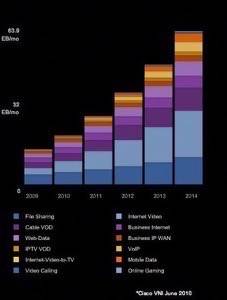In four years, Internet Protocol (IP) traffic will increase fourfold to 767 exabytes, or more than three-quarters of a zettabyte. That is equivalent to 16 billion DVDs; 21 trillion MP3’s; or 399 quadrillion text messages.

That’s the conclusion of Cisco’s annual Visual Networking Index, a report that demonstrates how data will soon become ubiquitous and why the networking race is becoming one to watch.
We are in the midst of a time when cloud computing and virtualization go way beyond affecting just servers and storage. The network is deeply affected, too, as the client/server system to deliver applications to users is replaced by cloud computing and virtualized environments.
Layer on top the exponential data that traverses IP networks and the competitive environment only gets more interesting.
Mike Banic, vice president of enterprise marketing for Juniper Networks puts it this way in an interview this week in IT Business Edge:
“Server-to-server traffic over the old network is equivalent to flying from Boston to New York City via Buffalo, Chicago, and Philadelphia and having to go through security again at every stop. The new network must deliver a direct flight with a streamlined security process to improve the experience for users and lower the cost of deploying and operating the data center network.”
And that’s just with today’s amount of data. According to Cisco, the amount of data traveling across IP networks in 2014 will be 10 times the total of all traffic traveling across IP networks in 2008.

On a per month basis, the total amount of data flowing on a monthly basis in 2014 will be nearly 64 exabytes of global IP traffic per month. Just for perspective, one exabyte equals 50,000 years of DVD video.
It’s a mind boggling number but is reflective of a number of other trends that we are covering on almost a daily basis at ReadWriteWeb.
Advancement in virtualization are driving the current competition. Cisco is leading the market but it does have its challengers, which until recently were not seen as much of a threat. That’s changing as the data center becomes in essence one virtualized computer with the network as the backplane.
Zeus Kerravala of Yankee Group makes the backplane analogy and says this new dynamic is creating more disruption than the market has seen in a long time:
“So what does this all mean? It means that for the first time in a long time, simply buying the status quo may not be the right decision. Much of the decision may depend on whose compute and virtualization technology is used. The ability to solve the virtualization problem will far outweigh brand, the number of certified engineers or market share as this is the computing foundation companies will use for the next decade. Only time will tell whose solution works best but for the first time in a long time, we’ve got a fair fight on our hands.”
What’s at stake is represented in the projections that Cisco is presenting in its report. Network innovation will be required to sustain these levels of traffic:
- North America will generate the most IP traffic with 19 exabytes per month.
- The fastest growing region will be Latin America with a 51% compound annual growth rate.
- Video will dominate, exceeding 91% of global traffic.
- In 2014, about 87% of traffic will be generated by consumers.
- From 2009-2014, global mobile data traffic will increase 39 times.
How the IP network of the future behaves will be in large part shaped by the realities of exponential data flows.
To win, Cisco is betting on its established presence in the market and its unified communications strategy. Juniper is betting on its vision of network fabric. Avaya is in the race, too,
We still have to see how HP emerges but its mantra about openness and simplicity has helped it catch up to Cisco. It may be in the best position of all with its servers, storage and arsenal of computing power, management software and services.
Will the cost benefits of a simpler, open network outweigh the benefits of Cisco’s tremendous technology infrastructure? How will the data disruption affect the networking giants?
Those are the big question as we continue to adapt to a world where science fiction seems more like reality every day.










